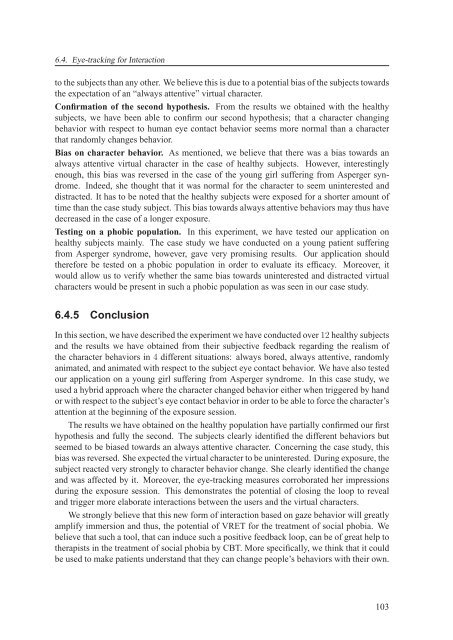Texte intégral / Full text (pdf, 20 MiB) - Infoscience - EPFL
Texte intégral / Full text (pdf, 20 MiB) - Infoscience - EPFL
Texte intégral / Full text (pdf, 20 MiB) - Infoscience - EPFL
You also want an ePaper? Increase the reach of your titles
YUMPU automatically turns print PDFs into web optimized ePapers that Google loves.
6.4. Eye-tracking for Interaction<br />
to the subjects than any other. We believe this is due to a potential bias of the subjects towards<br />
the expectation of an “always attentive” virtual character.<br />
Confirmation of the second hypothesis. From the results we obtained with the healthy<br />
subjects, we have been able to confirm our second hypothesis; that a character changing<br />
behavior with respect to human eye contact behavior seems more normal than a character<br />
that randomly changes behavior.<br />
Bias on character behavior. As mentioned, we believe that there was a bias towards an<br />
always attentive virtual character in the case of healthy subjects. However, interestingly<br />
enough, this bias was reversed in the case of the young girl suffering from Asperger syndrome.<br />
Indeed, she thought that it was normal for the character to seem uninterested and<br />
distracted. It has to be noted that the healthy subjects were exposed for a shorter amount of<br />
time than the case study subject. This bias towards always attentive behaviors may thus have<br />
decreased in the case of a longer exposure.<br />
Testing on a phobic population. In this experiment, we have tested our application on<br />
healthy subjects mainly. The case study we have conducted on a young patient suffering<br />
from Asperger syndrome, however, gave very promising results. Our application should<br />
therefore be tested on a phobic population in order to evaluate its efficacy. Moreover, it<br />
would allow us to verify whether the same bias towards uninterested and distracted virtual<br />
characters would be present in such a phobic population as was seen in our case study.<br />
6.4.5 Conclusion<br />
In this section, we have described the experiment we have conducted over 12 healthy subjects<br />
and the results we have obtained from their subjective feedback regarding the realism of<br />
the character behaviors in 4 different situations: always bored, always attentive, randomly<br />
animated, and animated with respect to the subject eye contact behavior. We have also tested<br />
our application on a young girl suffering from Asperger syndrome. In this case study, we<br />
used a hybrid approach where the character changed behavior either when triggered by hand<br />
or with respect to the subject’s eye contact behavior in order to be able to force the character’s<br />
attention at the beginning of the exposure session.<br />
The results we have obtained on the healthy population have partially confirmed our first<br />
hypothesis and fully the second. The subjects clearly identified the different behaviors but<br />
seemed to be biased towards an always attentive character. Concerning the case study, this<br />
bias was reversed. She expected the virtual character to be uninterested. During exposure, the<br />
subject reacted very strongly to character behavior change. She clearly identified the change<br />
and was affected by it. Moreover, the eye-tracking measures corroborated her impressions<br />
during the exposure session. This demonstrates the potential of closing the loop to reveal<br />
and trigger more elaborate interactions between the users and the virtual characters.<br />
We strongly believe that this new form of interaction based on gaze behavior will greatly<br />
amplify immersion and thus, the potential of VRET for the treatment of social phobia. We<br />
believe that such a tool, that can induce such a positive feedback loop, can be of great help to<br />
therapists in the treatment of social phobia by CBT. More specifically, we think that it could<br />
be used to make patients understand that they can change people’s behaviors with their own.<br />
103

















